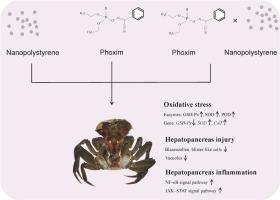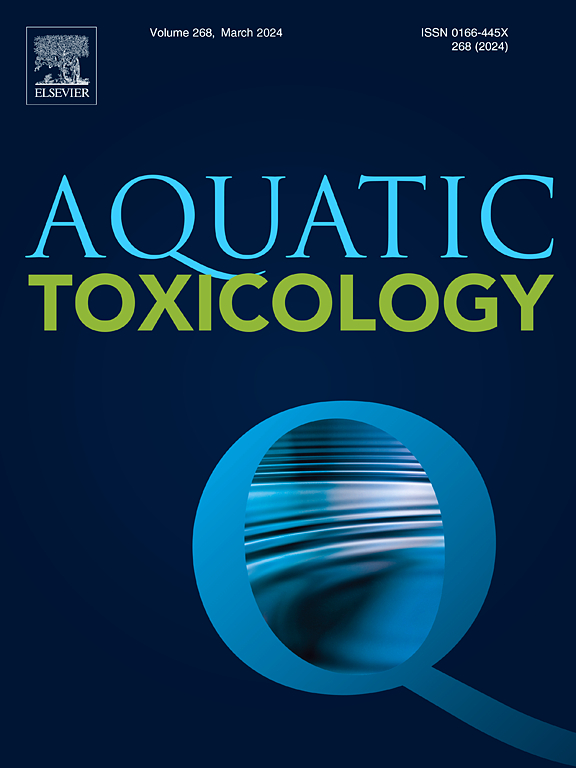纳米多苯乙烯和辛硫磷污染:中华绒螯蟹肝胰腺毒性的威胁
IF 4.1
2区 环境科学与生态学
Q1 MARINE & FRESHWATER BIOLOGY
引用次数: 0
摘要
自然环境中广泛存在的污染物辛硫磷(PHO)和纳米聚苯乙烯(NP)引起了人们的极大关注。本研究评估了 NP 和/或 PHO 在环境中的浓度对中华鳖肝胰脏的毒性影响。亚慢性接触 NP 和/或 PHO 会在 21 天的接触期内引发肝胰腺组织学损伤。NP组、PHO组和共同暴露组(NPO)的水泡样(B)细胞减少,并出现空泡化。此外,这些暴露还导致肝小管粘液屏障和机械屏障受损,氧化应激相关基因、粘蛋白相关基因和 TJ 相关基因的表达发生了改变。此外,还观察到免疫相关基因和炎症细胞因子基因表达的改变。研究结果表明,单独或同时暴露于 NP 和 PHO 都会引起肝胰腺炎症,而且同时暴露会加剧炎症反应。转录组分析进一步研究了肝胰腺毒性的可能途径。亚慢性暴露于PHO和共同暴露会引起肝胰腺炎症;共同暴露会加剧这种炎症,并通过靶向相关基因激活NF-κB信号通路。总之,根据我们的理解,这项研究首次记录了环境中的 NP 和/或 PHO 暴露水平对甲壳类肝胰腺粘液和机械屏障的破坏作用,并引发炎症反应。这些发现凸显了氮磷和/或酚类氧化物污染对肝胰脏健康的重要影响。本文章由计算机程序翻译,如有差异,请以英文原文为准。

Nanopolystyrene and phoxim pollution: A threat to hepatopancreas toxicity in Chinese mitten crab (Eriocheir sinensis)
Significant concerns have been raised by the widespread pollutants phoxim (PHO) and nanopolystyrene (NP) in the natural environment. This study evaluated the toxicity effects on the hepatopancreas of Eriocheir sinensis caused by NP and/or PHO at concentrations found in the environment. Subchronic exposure to NP and/or PHO triggered hepatopancreas histological damage within a 21-day exposure period. The NP, PHO, and co-exposure (NPO) groups exhibited fewer blister-like (B) cells, along with the appearance of vacuolation. Furthermore, these exposures induced impairment in the hepatic tubule mucus barrier and mechanical barrier, as evidenced by altered expression of oxidative stress-related genes, mucin-related genes, and TJ-related genes. Additionally, alterations in immunity-related genes and inflammatory cytokine genes expression were observed. The findings showed that hepatopancreas inflammation was caused by both individual and combined exposure to NP and PHO and that the inflammatory response was exacerbated by the co-exposure. The possible pathways of hepatopancreas toxicity were further investigated by transcriptomic analysis. Hepatopancreas inflammation was brought on by subchronic exposure to PHO and co-exposure; this inflammation was exacerbated by co-exposure and was backed by the activation of NF-κB signaling pathway via targeting-related genes. In summary, this research represents the initial documentation, to the best of our understanding of the detrimental effects of exposured to NP and/or PHO at levels found in the environment disrupt the hepatopancreas mucus and mechanical barrier in crustaceans, triggering inflammatory responses. These findings highlight the significance of NP and/or PHO pollution for hepatopancreas health.
求助全文
通过发布文献求助,成功后即可免费获取论文全文。
去求助
来源期刊

Aquatic Toxicology
环境科学-毒理学
CiteScore
7.10
自引率
4.40%
发文量
250
审稿时长
56 days
期刊介绍:
Aquatic Toxicology publishes significant contributions that increase the understanding of the impact of harmful substances (including natural and synthetic chemicals) on aquatic organisms and ecosystems.
Aquatic Toxicology considers both laboratory and field studies with a focus on marine/ freshwater environments. We strive to attract high quality original scientific papers, critical reviews and expert opinion papers in the following areas: Effects of harmful substances on molecular, cellular, sub-organismal, organismal, population, community, and ecosystem level; Toxic Mechanisms; Genetic disturbances, transgenerational effects, behavioral and adaptive responses; Impacts of harmful substances on structure, function of and services provided by aquatic ecosystems; Mixture toxicity assessment; Statistical approaches to predict exposure to and hazards of contaminants
The journal also considers manuscripts in other areas, such as the development of innovative concepts, approaches, and methodologies, which promote the wider application of toxicological datasets to the protection of aquatic environments and inform ecological risk assessments and decision making by relevant authorities.
 求助内容:
求助内容: 应助结果提醒方式:
应助结果提醒方式:


